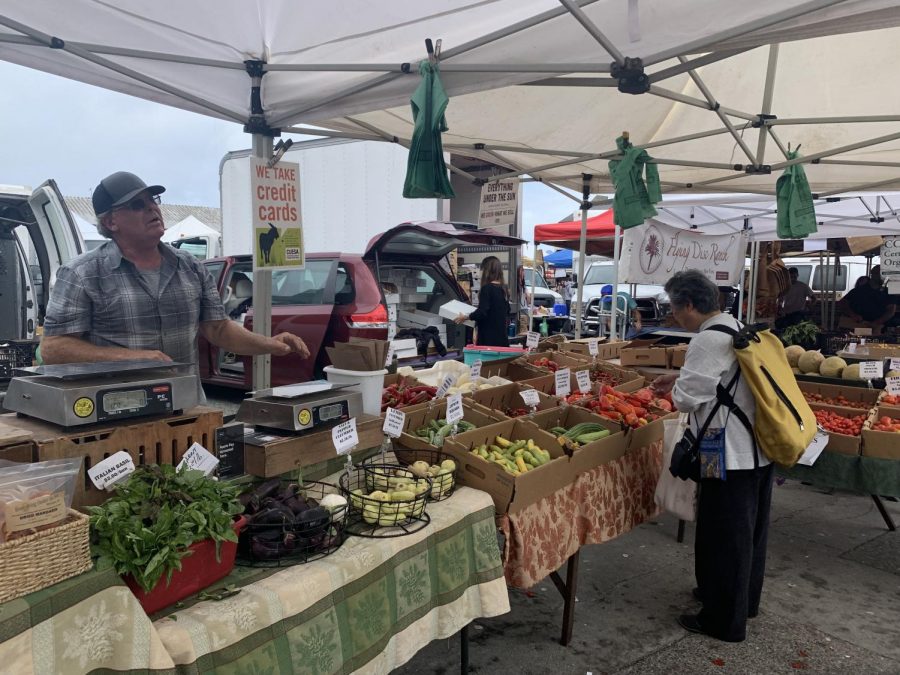Organic, sustainable, GMO?
Farmer Bill Crepps of the farm Everything Under the Sun sells his dried fruit to a customer at the Ferry Plaza Farmers Market. Crepps farms his fruits and vegetables using sun-drying methods that achieve organic status and employ sustainable methods.
October 7, 2019
Strolling down the colorful aisles of Whole Foods on the corner of Franklin and California streets, displays stocked with strawberries, tomatoes and blueberries that are labeled “organic,” “sustainable” and “genetically modified” can confuse many shoppers.
Almost three-quarters of American consumers know nothing or very little about the implications of these labels according to a U.S. Farmers & Ranchers Alliance survey.
“I didn’t know what made something sustainable for the longest time,” junior Bella Wasserman said. “It’s really hard to get a solid definition.”
Environmental sustainability is farming and producing crops through selective methods that do not impact other systems. Achieving an entirely sustainable farm calls for persistence and hard labor.
“A sustainable business and farm require a huge amount of effort,” Lee James, Co-Owner of Tierra Vegetables of Santa Rosa, said. “If all of the consumers in the world were to turn into the kinds of people who shop at farmers’ markets rather than at Walmart, sustainable farming would be realistic.”
Walmart’s sustainability initiative began in 2005, when CEO Lee Scott realized that the threat of global warming was real, setting him on a course that altered the structure of the world’s largest retailer. Their sustainability program is accompanied by three goals: to create zero waste, to operate with 100% renewable energy and to sell products that sustain resources and the environment.
Farmers also consider GMOs, produce varieties created through genetic modification, when farming food sustainably and reliably according to the USDA Agricultural Biotechnology Glossary. Instead of producing GMOs, sustainable farmers may use hybrids of plants as substitutes, according to Bill Crepps.
Crepps grows hybrid tomatoes, developed from two different parent plants that are crossed to form another species of that tomato. The process of genetically modifying an organism differs in that genes from organisms combine with other genes that would not naturally cross.
“GMOs play around with the natural currency and that’s where the controversy lies,” Crepps said. “I believe that it could be a valuable tool in the future though, especially with climate change and global warming as more plants have to adapt to the ever-changing environment.”
Not everyone agrees, though, on the safety of GMOs.
“Foods that have been genetically modified are a big threat to healthy eaters,” Ritchie said. “I have never and will never eat food that has been genetically modified because they just pose too many health hazards and are super controversial.”
There is evidence that genetically modified organisms will impact directly on human health through damage to the digestive system, which can produce chronic illnesses according to the United States Department of Agriculture. GMOs also pose a serious threat to farmer sovereignty and to the security of the farm where they are grown.
Earning the United States Department of Agriculture label “organic” requires that foods are grown and processed according to federal guidelines. These include soil quality, animal raising methods, pest and weed control and use of additives, according to the USDA.
“You farm using only naturally occurring substances which means that everything we use, including pesticides, can be found somewhere in nature,” Bill Crepps, manager of Everything Under the Sun of Winters, California, said. “What I find most interesting is that there haven’t been many good studies showing that organic food is actually that much healthier than eating regular food.”
The demand for organic foods has increased over the last few decades and supermarkets and restaurants have been responsive to consumers by working with and selling or using organically certified fruits and vegetables. Twenty-five percent of interviewees eat organic food for health-related reasons, while concern for the environment and concern for animal welfare are also factors, according to a survey by TreeHugger.
There currently is no scientific evidence that organic foods are healthier and better alternatives to conventional counterparts, but they have fewer synthetic pesticides and fertilizers and are free of hormones and antibiotics. It is also unclear whether the pesticides used in organic farming are safer than pesticides used in conventional farming.
As the world becomes increasingly affected by climate change, achieving sustainability will become more of a challenge for farmers. Organically certified foods will inevitably be placed under stricter guidelines as the world becomes more selective in the food choices they made. The science of GMOs will improve to acquire a less controversial perception and will develop in its technology, according to Crepps.
“I’m very optimistic about the future of farming,” James said. “I can’t wait to see how as the world changes evolutionarily and biologically, how we farm will change too. All I know is that however technologically savvy the world gets, farming is farming.”











